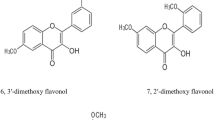Abstract
Background
GABAA receptors have been implicated in the pathophysiology of depression, epilepsy and pain disorders. The purpose of this study was to investigate two novel synthetic flavones, 3′-methoxy-6-methylflavone (3′-MeO6MF) and 3′-hydroxy-6-methylflavone (3′-OH6MF), for their effect on GABAA receptors and subsequently investigate their antidepressant, anticonvulsant and antinociceptive effects.
Methods
Recombinant GABAA receptor subunits were expressed in Xenopus oocytes and a two electrode voltage clamp technique was used for electrophysiological studies. The antidepressant and anticonvulsant activities were determined using forced swim (FST) and tail suspension tests (TST) and bicuculline (BIC)-induced seizures respectively. Furthermore, the antinociceptive activity was determined using tail immersion and hot plate tests.
Results
3′-MeO6MF and 3′-OH6MF potentiated GABA-induced currents through ternary α1-2β1-3γ2L and binary α1β2 receptors indicating that the positive modulation by these flavonoids is not dependent on the γ subunit. In behavioral studies, 3′-MeO6MF and 3′-OH6MF (10–100 mg/kg, ip) exerted significant antidepressant like effects in the FST and TST. 3′-MeO6MF (10–100 mg/kg) and 3′-OH6MF (30 and 100 mg/kg) also exhibited significant anticonvulsant effects in BIC-induced seizures, and antinociceptive activity in tail immersion and hot plate tests (* p < 0.05, ** p < 0.01, *** p < 0.001). Furthermore, the antidepressant and antinociceptive activities of 3′-MeO6MF and 3′-OH6MF were partially ameliorated by co-administration of BIC (3 mg/kg) suggesting the involvement of GABAergic mechanisms.
Conclusion
The findings of this study suggest that 3′-MeO6MF and 3′-OH6MF exhibited significant antidepressant, anticonvulsant and antinociceptive effects mediated via interactions with GABAA receptors.
Similar content being viewed by others
References
Chebib M, Johnston GA. GABA-activated ligand gated ion channels: medicinal chemistry and molecular biology. J Med Chem 2010;43:1427–47.
Johnston GA. GABA(A) receptor channel pharmacology. Curr Pharm Des 2005;11:1867–85.
Henschel O, Gipson KE, Bordey A. GABAA receptors, anesthetics and anticonvulsants in brain development. CNS Neurol Disord Drug Targets 2008;7:211–24.
Carter CR, Kozuska JL, Dunn SM. Insights into the structure and pharmacology of GABA(A) receptors. Future Med Chem 2010;2:859–75.
Johnston GA. GABA-A receptor pharmacology. Pharmacol Ther 1996;69:173–8.
Christopoulos A. Allosteric binding sites on cell-surface receptors: novel targets for drug discovery. Nat Rev Drug Discov 2002;1:198–210.
Belelli D, Harrison NL, Maguire J, Macdonald RL, Walker MC, Cope DW. Extrasynaptic GABAA receptors: form, pharmacology, and function. J Neurosci 2009;29:12757–63.
Harborne JB, Williams CA. Advances in flavonoid research since 1992. Phytochemistry 2000;55:481–504.
Heidari MR, Foroumadi A, Amirabadi A, Samzadeh-Kermani A, Azimzadeh BS, et al. Evaluation of anti-inflammatory and analgesic activity of a novel rigid 3, 4-dihydroxy chalcone in mice. Ann N Y Acad Sci 2009;1171:399–406.
Luk K-C, Stern L, Weigele M, O’Brien RA, Spirt N. Isolation and identification of “diazepam-like” compounds from bovine urine. J Nat Prod 1983;46:852–61.
Karim N, Curmi J, Gavande N, Johnston GA, Hanrahan JR, Tierney ML, et al. 2′-Methoxy-6-methylflavone: a novel anxiolytic and sedative with subtype selective activating and modulating actions at GABA(A) receptors. Br J Pharmacol 2012;165:880–96.
Karim N, Gavande N, Wellendorph P, Johnston GA, Hanrahan JR, Chebib M, et al. 3-Hydroxy-2′-methoxy-6-methylflavone: a potent anxiolytic with a unique selectivity profile at GABAA receptor subtypes. Biochem Pharmacol 2011;82:1971–83.
Hall BJ, Chebib M, Hanrahan JR, Johnston GAR. Flumazenil-independent positive modulation of γ-aminobutyric acid action by 6-methylflavone at human recombinant α1β2γ2L and α1β2 GABAA receptors. Eur J Pharmacol 2004;491:1–8.
Hall BJ, Karim N, Chebib M, Johnston GA, Hanrahan JR. Modulation of ionotropic GABA receptors by 6-methoxyflavanone and 6-methoxyflavone. Neurochem Res 2014;39:1068–78.
Kahnberg P, Lager E, Rosenberg C, Schougaard J, Camet L, Sterner O, et al. Refinement and evaluation of a pharmacophore model for flavone derivatives binding to the benzodiazepine site of the GABAAreceptor. J Med Chem 2002;45:4188–201.
Karim N, Irshad S, Khan I, Mohammad A, Anis I, Shah MR, et al. GABA(A) receptor modulation and neuropharmacological activities of viscosine isolated from Dodonaea viscosa (Linn). Pharmacol Biochem Behav 2015;136:64–72.
Abdelhalim A, Karim N, Chebib M, Aburjai T, Khan I, Johnston GA, et al. Antidepressant, anxiolytic and antinociceptive activities of constituents from rosmarinus officinalis. J Pharm Pharm Sci 2015;18:448–59.
Tita B, Abdel-Haq H, Vitalone A, Mazzanti G, Saso L. Analgesic properties of Epilobium angustifolium, evaluated by the hot plate test and the writhing test. Farmaco 2001;56:341–3.
Steru L, Chermat R, Thierry B, Simon P. The tail suspension test: a new method for screening antidepressants in mice. Psychopharmacology (Berlin) 1985;85:367–70.
Cryan JF, Markou A, Lucki I. Assessing antidepressant activity in rodents: recent developments and future needs. Trends Pharmacol Sci 2002;23:238–45.
Skerritt JH, Trisdikoon P, Johnston GA. Increased GABA binding in mouse brain following acute swim stress. Brain Res 1981;215:398–403.
Rosa PB, Neis VB, Ribeiro CM, Moretti M, Rodrigues AL. Antidepressant-like effects of ascorbic acid and ketamine involve modulation of GABA-A and GABA-B receptors. Pharmacol Rep 2016;68:996–1001.
Mohler H. The GABA system in anxiety and depression and its therapeutic potential. Neuropharmacology 2012;62:42–53.
Dibbens LM, Feng H-J, Richards MC, Harkin LA, Hodgson BL, Scott D, et al. GABRD encoding a protein for extra- or peri-synaptic GABAA receptors is a susceptibility locus for generalized epilepsies. Hum Mol Genet 2004;13:1315–9.
Macdonald RL, Kang JQ, Gallagher MJ, Feng HJ. GABA(A) receptor mutations associated with generalized epilepsies. Adv Pharmacol 2006;54:147–69.
Enna SJ, Mohler H. The GABA Receptors. New York: Humana Press; 1980.
Treiman DM. GABAergic mechanisms in epilepsy. Epilepsia 2001;42(Suppl. 3):8–12.
Srinivasan K, Muruganandan S, Lal J, Chandra S, Tandan SK, Raviprakash V, et al. Antinociceptive and antipyretic activities of Pongamia pinnata leaves. Phytother Res 2003;17:259–64.
Waszkielewicz AM, Gunia A, Szkaradek N, Sloczynska K, Krupinska S, Marona H, et al. Ion channels as drug targets in central nervous system disorders. Curr Med Chem 2013;20:1241–85.
Author information
Authors and Affiliations
Corresponding author
Supplementary data
Rights and permissions
About this article
Cite this article
Karim, N., Khan, I., Ahmad, N. et al. Antidepressant, anticonvulsant and antinociceptive effects of 3′-methoxy-6-methylflavone and 3′-hydroxy-6-methylflavone may involve GABAergic mechanisms. Pharmacol. Rep 69, 1014–1020 (2017). https://doi.org/10.1016/j.pharep.2017.03.001
Received:
Revised:
Accepted:
Published:
Issue Date:
DOI: https://doi.org/10.1016/j.pharep.2017.03.001




